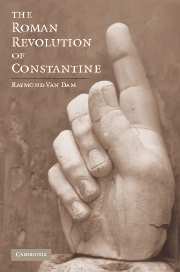Book contents
- Frontmatter
- Contents
- PREFACE
- ABBREVIATIONS
- Map
- Introduction: AUGUSTUS AND CONSTANTINE
- SECTION I A ROMAN EMPIRE WITHOUT ROME
- 1 CONSTANTINE'S RESCRIPT TO HISPELLUM
- 2 HIS FAVORITE ROOSTER: OLD ROME AND NEW ROME
- 3 “HOPE IN HIS NAME”: THE FLAVIAN DYNASTY
- 4 READING AHEAD
- SECTION II A GREEK ROMAN EMPIRE
- SECTION III EMPEROR AND GOD
- Epilogue: ONE EMPEROR
- APPENDIX 1 HISPELLUM: DATE, TEXT, AND TRANSLATION
- APPENDIX 2 ORCISTUS: DATES, TEXT, AND TRANSLATION
- EDITIONS AND TRANSLATIONS
- BIBLIOGRAPHY
- INDEX
1 - CONSTANTINE'S RESCRIPT TO HISPELLUM
Published online by Cambridge University Press: 05 June 2012
- Frontmatter
- Contents
- PREFACE
- ABBREVIATIONS
- Map
- Introduction: AUGUSTUS AND CONSTANTINE
- SECTION I A ROMAN EMPIRE WITHOUT ROME
- 1 CONSTANTINE'S RESCRIPT TO HISPELLUM
- 2 HIS FAVORITE ROOSTER: OLD ROME AND NEW ROME
- 3 “HOPE IN HIS NAME”: THE FLAVIAN DYNASTY
- 4 READING AHEAD
- SECTION II A GREEK ROMAN EMPIRE
- SECTION III EMPEROR AND GOD
- Epilogue: ONE EMPEROR
- APPENDIX 1 HISPELLUM: DATE, TEXT, AND TRANSLATION
- APPENDIX 2 ORCISTUS: DATES, TEXT, AND TRANSLATION
- EDITIONS AND TRANSLATIONS
- BIBLIOGRAPHY
- INDEX
Summary
Constantine replied to the petition from hispellum and the other Umbrian cities sometime after late December 333, and most likely before mid-September 335. During this period he was either in or near Constantinople, or he was campaigning in the Balkans. Unless there had been a long delay in his response, the cities had presumably sent their petition shortly before.
ITALY FOREVER
Hispellum and these other cities in Umbria were reacting in part to fairly recent changes in the administration of Italy. Already during Augustus' reign the peninsula had been divided into eleven geographical regiones. The region that included Rome was, of course, the first region, and through his patronage and favoritism Augustus made clear that no other city in the empire, in particular one of the great cities in the East such as Alexandria or Antioch, would become a rival: “hereafter Rome would never be anywhere but in Rome.” In central Italy north of Rome the upper Tiber River divided Etruria (sometimes known as Tuscia) as the seventh region from Umbria to its east as the sixth region. Since central and southern Italy shared in the elevated prestige of Rome, from the beginning the cities of peninsular Italy had long had a favored standing within the empire. “Italy tended to be treated by the emperors as something of an extension of the city of Rome.” Augustus and his successors funded municipal buildings, temples, walls, and aqueducts, provided aid after natural disasters, and built or repaired roads everywhere.
- Type
- Chapter
- Information
- The Roman Revolution of Constantine , pp. 23 - 34Publisher: Cambridge University PressPrint publication year: 2007

